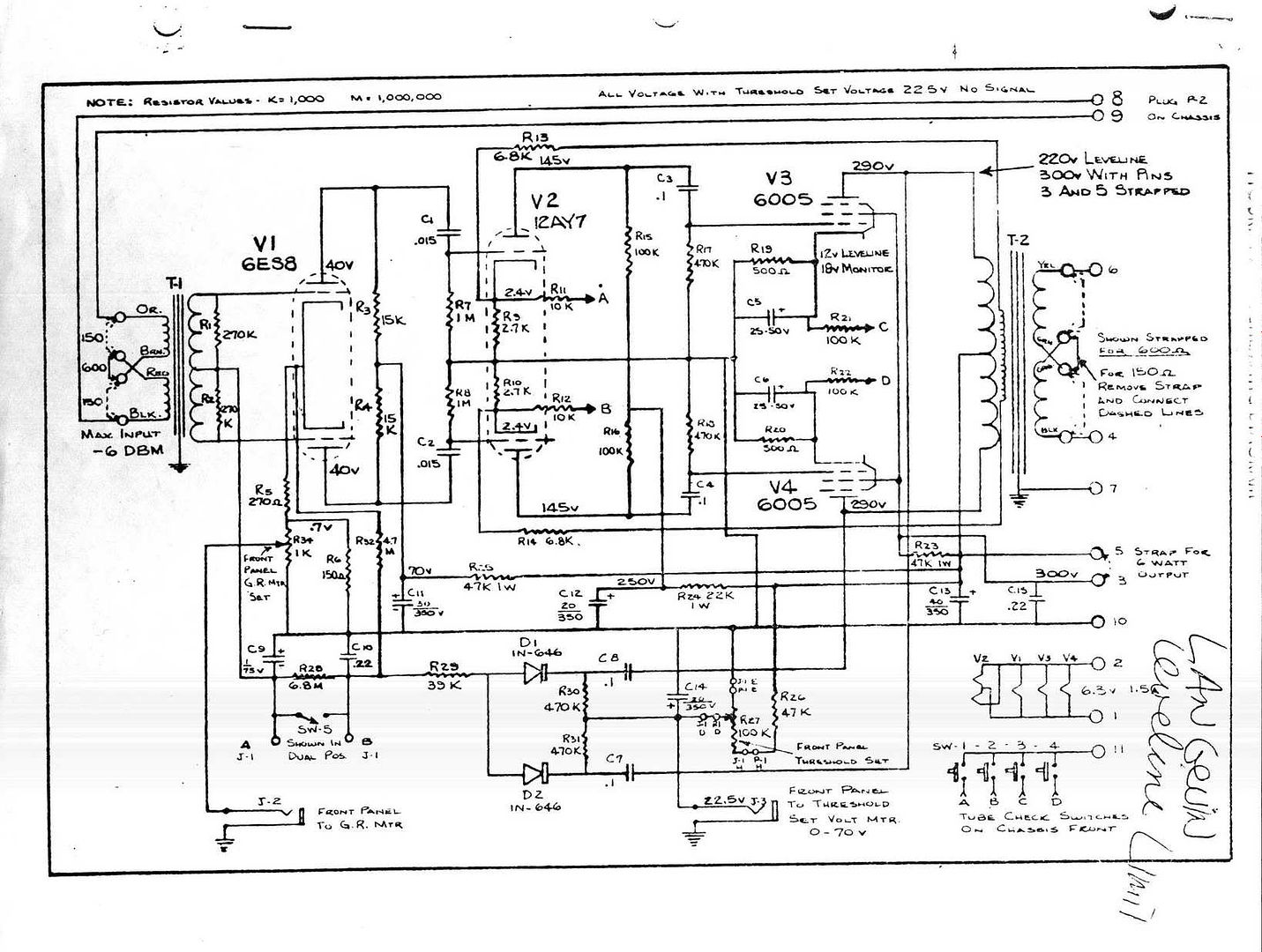You are using an out of date browser. It may not display this or other websites correctly.
You should upgrade or use an alternative browser.
You should upgrade or use an alternative browser.
schematics for langevin 5301
- Thread starter wilebee
- Start date
Help Support GroupDIY Audio Forum:
This site may earn a commission from merchant affiliate
links, including eBay, Amazon, and others.
Just the 5116b. Sorry. What is the one your after? Mic pre?
Butterylicious
Well-known member
I have several Langevin schematics but nothing on the 5301. All my stuff is preamp & amp. I did find 5 pages of Langevin transformer specifications. I've been trying to scan all my schematics and get them posted.
rafafredd
Well-known member
Don´t know if this is the one, but it´s a compressor using the 6ES8 allright... It´s usually called leveline.


Where are the A, B, C and D nodes are going to?
Surely the A, B from the cathodes of the AY7 are not going to the A, B in the attack/release time constant network ?!
And, is there a picture, or even a user manual of this online somewhere?
JH.
Surely the A, B from the cathodes of the AY7 are not going to the A, B in the attack/release time constant network ?!
And, is there a picture, or even a user manual of this online somewhere?
JH.
rafafredd
Well-known member
mmm probably just test points to match the tubes?
[quote author="rafafredd"]mmm probably just test points to match the tubes?[/quote]
Makes sense. 'Twas the 10k and 100k resistors that confused me - thought they'd have to go somewhere. But then they'r probably just in for protection / isolation of the probes. Never seen this in my ususal circuit reading (synthesizers), but with tubes and their high voltages it certainly makes sense.
JH.
Makes sense. 'Twas the 10k and 100k resistors that confused me - thought they'd have to go somewhere. But then they'r probably just in for protection / isolation of the probes. Never seen this in my ususal circuit reading (synthesizers), but with tubes and their high voltages it certainly makes sense.
JH.
[quote author="jhaible"]Where are the A, B, C and D nodes are going to?[/quote]
To A, B, C and D at the bottom right (the pushbuttons). The resistors are there to prevent accidents if somebody pushes more than one button at a time.
Best regards,
Mikkel C. Simonsen
To A, B, C and D at the bottom right (the pushbuttons). The resistors are there to prevent accidents if somebody pushes more than one button at a time.
Best regards,
Mikkel C. Simonsen
[quote author="mcs"][quote author="jhaible"]Where are the A, B, C and D nodes are going to?[/quote]
To A, B, C and D at the bottom right (the pushbuttons). The resistors are there to prevent accidents if somebody pushes more than one button at a time.
Best regards,
Mikkel C. Simonsen[/quote]
Ok, I see. No slam mode here. :wink:
JH.
To A, B, C and D at the bottom right (the pushbuttons). The resistors are there to prevent accidents if somebody pushes more than one button at a time.
Best regards,
Mikkel C. Simonsen[/quote]
Ok, I see. No slam mode here. :wink:
JH.
NewYorkDave
Well-known member
That was very common with plug-in amplifiers. The output side of those pushbuttons would go to a buss in the console that fed a "tube check" meter. The tapping point for the cathode voltage at each tube--or, in this case, the value of series resistance to limit the current through the meter--would be selected to give a "100%" reading on the meter when the cathode voltage (and therefore the plate current) was at the normal value for a healthy tube. Pushing in the buttons one by one, while reading the tube-check meter, was part of the maintenance technician's daily routine in the studio.
[quote author="NewYorkDave"]That was very common with plug-in amplifiers. The output side of those pushbuttons would go to a buss in the console that fed a "tube check" meter. The tapping point for the cathode voltage at each tube--or, in this case, the value of series resistance to limit the current through the meter--would be selected to give a "100%" reading on the meter when the cathode voltage (and therefore the plate current) was at the normal value for a healthy tube. Pushing in the buttons one by one, while reading the tube-check meter, was part of the maintenance technician's daily routine in the studio.[/quote]
Now, that makes even more sense than just protection resistors!
Thanks for explaining it.
JH.
Now, that makes even more sense than just protection resistors!
Thanks for explaining it.
JH.
ciminosound
Well-known member
If you search our archives for Langevin, Level line, 6es8, ect you will find more info on this unit. We've discussed it before, as far back as the "other" place too!
:sam:
:sam:
Similar threads
- Replies
- 6
- Views
- 740
- Replies
- 1
- Views
- 81





























![Electronics Soldering Iron Kit, [Upgraded] Soldering Iron 110V 90W LCD Digital Portable Soldering Kit 180-480℃(356-896℉), Welding Tool with ON/OFF Switch, Auto-sleep, Thermostatic Design](https://m.media-amazon.com/images/I/41gRDnlyfJS._SL500_.jpg)


